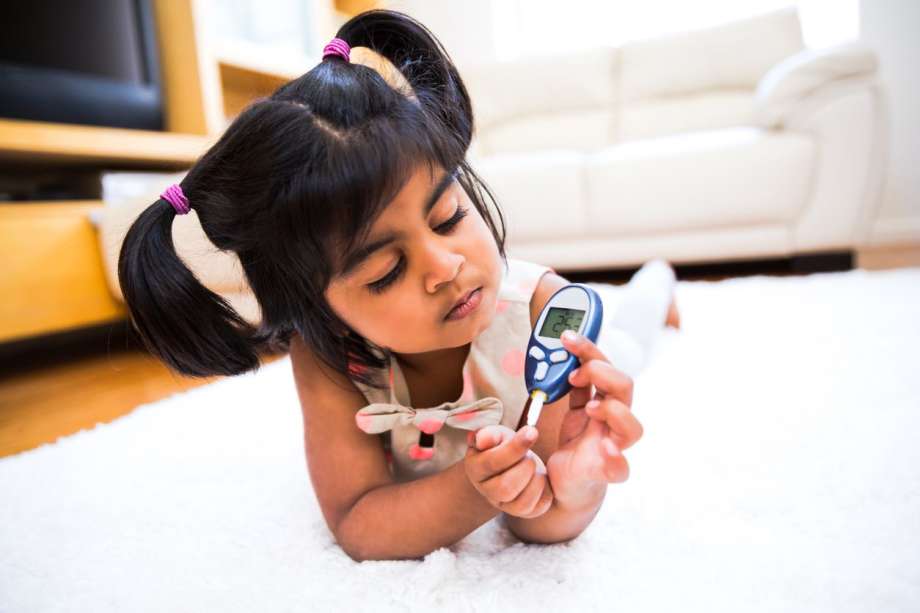Does My Kid Have Diabetes? Signs of Type 1 and 2 Diabetes in Children

Diabetes in kids is on the rise. According to the U.S. Centers for Disease Control and Prevention (CDC), there was a 20 percent increase in cases of Type 2 Diabetes in children and teens under age 20 between the years 2002 and 2015.
There was also a 1.9 percent increase in the number of children diagnosed with Type 1 Diabetes in the same time frame. The CDC’s stats show that in 2018 nearly 210,00 children were diagnosed with Diabetes. Whether you already suspect your child has Diabetes or you just want to learn more about the risks of Type 1 and Type 2, read on for more info on this chronic condition.
Related: How My Teenage Son Deals with Type 1 Diabetes in College
What is Diabetes?
This disease affects how the body uses glucose — its major source of energy. To properly use glucose, the human body needs insulin. Insulin is a hormone that the body normally makes inside of the pancreas. When a person eats, the pancreas should release insulin. The hormone then helps the body to convert glucose or store it.
In both types of Diabetes, glucose can’t get into the cells normally. This leads to an increase in blood sugar levels. Even though both Type 1 and type 2 diabetes can result in high blood sugar and the subsequent problems out-of-control glucose levels can cause, these insulin-related issues are not identical diseases.
What is Type 1 Diabetes?

Formerly known as juvenile diabetes, Type 1 Diabetes (a.k.a T1D) is an autoimmune disorder. Despite the all-too-popular belief that all Diabetes results from poor weight management or eating a sugar-packed diet, T1D is not preventable. While the exact cause of Type 1 Diabetes is still unknown, it’s believed that the disease results from a combination of genetic and environmental risk factors, according to the National Institute of Diabetes and Digestive and Kidney Disorders (NIDDK).
The environmental trigger (such as a viral infection) could kick off the immune response, leading the body to mistakenly start attacking its own cells.
Type 1 Diabetes occurs when a person’s immune system attacks the pancreas and destroys the cells that create insulin. Children and teens with T1D depend on daily injections of insulin or an insulin pump to control their blood glucose levels. This form of Diabetes often comes on suddenly.
Symptoms of Type 1 Diabetes May Include:
- Frequent urination or wetting the bed (in a potty-trained child)
- Constant or increased thirst
- Weight loss
- Increased hunger
- Increased fatigue
- Vision changes/blurred vision
- Moodiness
- Fruity smelling breath
Keep in mind that young children may not have the words to express how they’re feeling inside or even recognize the signs. This means you may notice symptoms of diabetes before your child does.
Along with watching for signs, ask other adults who see your child on a regular basis if they notice any of these symptoms. These adults could include the sitter, a nanny, your kiddo’s preschool teacher, a school teacher, or grandparents.
What is Type 2 Diabetes?

Children with Type 2 Diabetes can produce their own insulin, but the body can’t use it properly. This results in a buildup of sugar in the blood — in other words, high blood sugar. Even though this type of Diabetes is more common in adults, there are a growing number of children who are diagnosed with Type 2.
Unlike Type 1, Type 2 Diabetes is not an autoimmune issue. While genetics, especially a family history of Type 2 Diabetes, can play a role in the development of this disease, there are other factors at play. According to the NIDDK, people who are overweight or obese and physically inactive are more likely to have Type 2 Diabetes. Excess weight is a risk factor that can result in insulin resistance—especially belly fat.
Insulin resistance is typically the first step into Type 2 Diabetes. When the liver, muscle, and fat cells stop using insulin efficiently, the human body will need more of the hormone to process glucose. The result is an uptick in pancreatic function.
While this uptick in insulin production temporarily corrects the problem, it won’t last forever and isn’t a permanent fix. Unable to meet the body’s demand for insulin, blood glucose levels increase.
Symptoms of Type 2 Diabetes May Include
- Blurred vision
- Frequent urination
- Increased hunger
- Weight loss
- Excessive fatigue
- Infections more often than normal
- Sores that are slow to heal
- Numbness/tingling of the hands or feet
- Increased thirst
What Are the Possible Long-Term Complications?
Thinking about the long-term complications of Diabetes is scary for a parent. Even though your diabetic child may seem okay on most days, it’s important to understand the potential long-term complications and consequences of this disease.
According to the Mayo Clinic, possible Type 1 complications may include damage to the heart, blood vessels, nerves, kidneys, or eyes. Type 1 Diabetes may also increase your child’s risk for developing osteoporosis later in life. Along with these complications, Type 2 Diabetes can cause serious bacterial or fungal skin infections, sores that don’t heal easily, sleep apnea, or hearing impairment. Nerve damage can also make it easier to injure a toe or other part of the body.
How Can You Reduce the Risks of Diabetes?

Management is the key to reducing the risks and potential complications of both Type 1 and Type 2 Diabetes. Not only can uncontrolled blood sugar result in damage to vital body systems or severe infections, but both low and high glucose levels can also set a child up for serious, potentially life-threatening scenarios.
Closely Monitor Blood Sugar Levels
Even though you might think of high blood sugar levels as a primary problem for diabetics, low levels (a.k.a. hypoglycemia) can have devastating effects. While low blood sugar can happen with both types of Diabetes, it’s more common in Type 1.
There are several possible causes of hypoglycemia. These include taking too much insulin, eating too few carbohydrates (per unit of insulin), incorrect insulin dosage timing, the proportion of fat/protein/fiber in meals, increased physical activity, hot/humid weather, high altitudes, and even puberty, according to the CDC.
Low blood sugar requires immediate intervention. Recognizing the symptoms is crucial to prompt treatment. As your child learns more about how their body responds to insulin, they may start to notice symptoms of low blood sugar sooner. These can include a rapid heartbeat, shakiness, sweating, nervousness, confusion, irritability, dizziness, weakness, or hunger. Left untreated, low blood sugar levels can progress into seizures or loss of consciousness/coma.
Some children have no symptoms of low blood sugar, this makes it important to monitor blood sugar levels. Always treat low blood sugar at the first signs of hypoglycemia. Your child should never wait until their blood sugar drops to a level that causes severe symptoms. The endocrinologist (your child’s diabetes specialist) can help you to find quick, easy ways to raise your child’s blood sugar.
Keep Fast-Acting Carbs on Hand

Eating or drinking 15 to 20 grams of fast-acting carbs, such as glucose tablets or fruit juice, may help, according to the Mayo Clinic. Your child will need to check and recheck their blood sugar to make sure it is rising.
A severe drop in blood sugar may require the use of a glucagon injection or nasal spray. Synthetic glucagon causes the liver to release glucose that your child’s body stores. This can rapidly raise blood sugar levels. Along with glucagon injections/nasal spray, severely low blood sugar requires emergency medical assistance.
Severe hyperglycemia (high blood sugar levels) can also cause serious medical complications that require immediate attention. Without the right care, elevated blood sugar levels can cause confusion, weakness, nausea/vomiting, and even coma. Hyperglycemia can cause diabetic ketoacidosis (DKA).
This is a life-threatening condition that happens when the body’s cells are starved for glucose. Over time the body burns fat for energy. This produces ketones—chemicals created from the breakdown of fat. A buildup of ketones can make the blood more acidic than normal, poisoning the body. Like hypoglycemia, DKA is more common in people with Type 1. An at-home urine test can check for the presence of ketones. This can help to reduce the risk of DKA for your child.
How Can You Help Your Child to Manage Diabetes?
The answer to this common concern depends on more than a few factors. Primarily, the type of Diabetes. To start with — it’s possible for your child to live a completely normal (but somewhat different, sometimes) life with diabetes.
Celebrities such as Halle Berry and Tom Hanks, are active, travel the world, live fabulous lives, and have Type 2 Diabetes. Likewise, quarterback Jay Cutler, musician Nick Jonas, and model (and Kate Moss’s daughter) Lila Moss all have Type 1. The teen model, Lila Moss, even walked the runway sporting her insulin pump.
Consult a Pediatric Endocrinologist

The first step to effective Diabetes management is connecting with the right healthcare providers. A pediatric endocrinologist can help your child to learn more about the disease and monitor their progress.
Children with Type 2 Diabetes typically won’t need insulin injections. But they often must make lifestyle changes. Treatment may include a healthy diet, weight loss (if indicated), a new exercise routine, regular blood sugar monitoring, and possibly oral medications, according to Stanford Medicine Children’s Health.
A healthy diet and exercise are important for all children with Diabetes. But changes in eating and activity habits won’t cure or fully treat Type 1. People with Type 1 Diabetes must use insulin injections or an insulin pump. There are several different types of insulin: rapid-acting, short-acting, intermediate-acting, long-lasting, and ultra-long lasting.
Your child’s endocrinologist will prescribe insulin, educate you on calculating dosages for meals and snacks, recommend a meal and snack schedule/dietary plan, and show your child how to administer insulin via a syringe, pen, or pump. Other healthcare providers, such as a diabetes dietician may work with the endocrinologist. These professionals can help your child to stay healthy, answer questions, and monitor their progress.
Teach Kids How to Read a Glucose Monitor

Insulin is only part of the Diabetes management equation. Both Type 1 and Type 2 Diabetes will need to get blood tests and labs regularly. An initial A1C test can help to determine where your child is, in terms of the progression of this disease. Along with an A1C, which measures glucose levels over the past three months, your child may need to test their blood sugar daily.
If your child’s blood sugar is up and down, up and down, and up and down some more, consider a continuous glucose monitor (CGM). This device is exactly what the name sounds like. A CGM continuously monitors glucose levels. You will attach the sensor to your child’s body. They will need to wear this 24-7. The sensor communicates with another unit or your smartphone, providing readings and sounding an alarm if your child’s glucose level goes above or below normal.
Yes, Diabetes is challenging for children—and for parents. But this disease doesn’t have to rule your child’s life. Along with the medical aspects of Diabetes management, pay attention to your kiddo’s mental health. It’s normal for a child to feel anxious or depressed about a new Diabetes diagnosis.
Talk to your child openly about the changes that need to happen right now and in the future. A licensed therapist can work with your family during the initial adjustment period and beyond.

